|
Reptiles can be a misunderstood group of animals. It seems that most people who take a hike with our rangers eventually ask about snakes and the dangers of hiking in snake habitat. While there are two species of rattlesnakes that live around Lake Meredith, there are also many other species of reptiles which are far more commonly seen and pose no real danger to human visitors. Texas Horned Lizard Phrynosoma cornutum 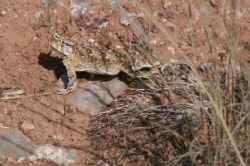
NPS Photo Loss of habitat and decline of harvester ant populations (its favorite food) contribute to the decline of Horny Toad populations.
Ornate Box Turtle Terrapene ornata 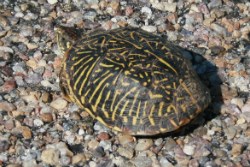
NPS Photo The carapace, or upper shell, of an Ornate Box Turtle is dark with brighter yellow 'starbursts' or lines. This species is a dry land turtle, often found in pastures and prairies. This turtle has a really good defense: its lower shell (or plastron) is hinged and allows the animal to completely withdraw into its shell for protection from predators like coyotes. Collared Lizard Crotaphytus collaris 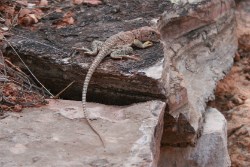
NPS PhotoCollared These lizards can be fun to watch. Males can be very territorial and often do push-ups when approached. When running at full speed, these lizards can pick up their front feet and run only on their hind feet.
Rattlesnakes Crotalus sp. 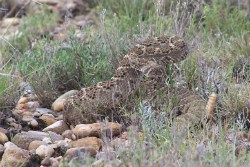
NPS Photo Around Lake Meredith, you might find two species of rattlesnakes: Prairie Rattlesnakes (C. viridis) and Western Diamondback Rattlesnakes (C. atrox). Feared by many, these venomous snakes make a distinctive warning rattle when approached. All rattlesnakes have a heat-sensing pit between their nostrils and their eyes, which can detect even the slightest difference in temperature. Their fangs are hollow and can deliver their venom quickly. Common Checkered Whiptail Lizard Aspidoscelis tesselata 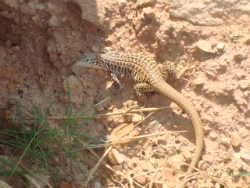
NPS Photo These lizards are strong females - you will never find a male of this species! This species reproduces asexually via parthenogenesis. One potential advantage of this method is that individuals don't have to expend a lot of energy looking for a mate, like in many other species. A potential disadvantage is the lack of genetic diversity that results from sexual reproduction with two specimens.
|
Last updated: December 21, 2015
